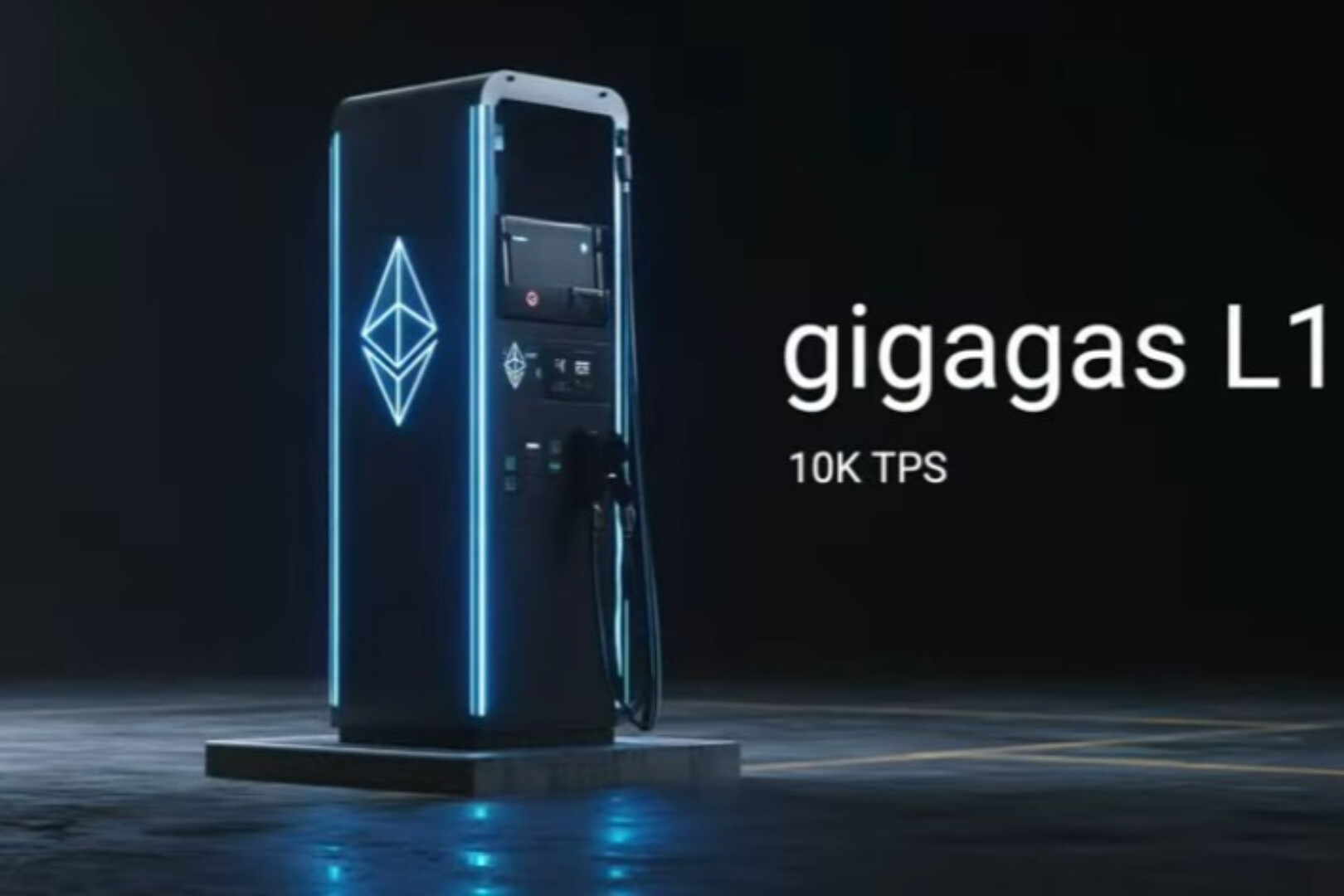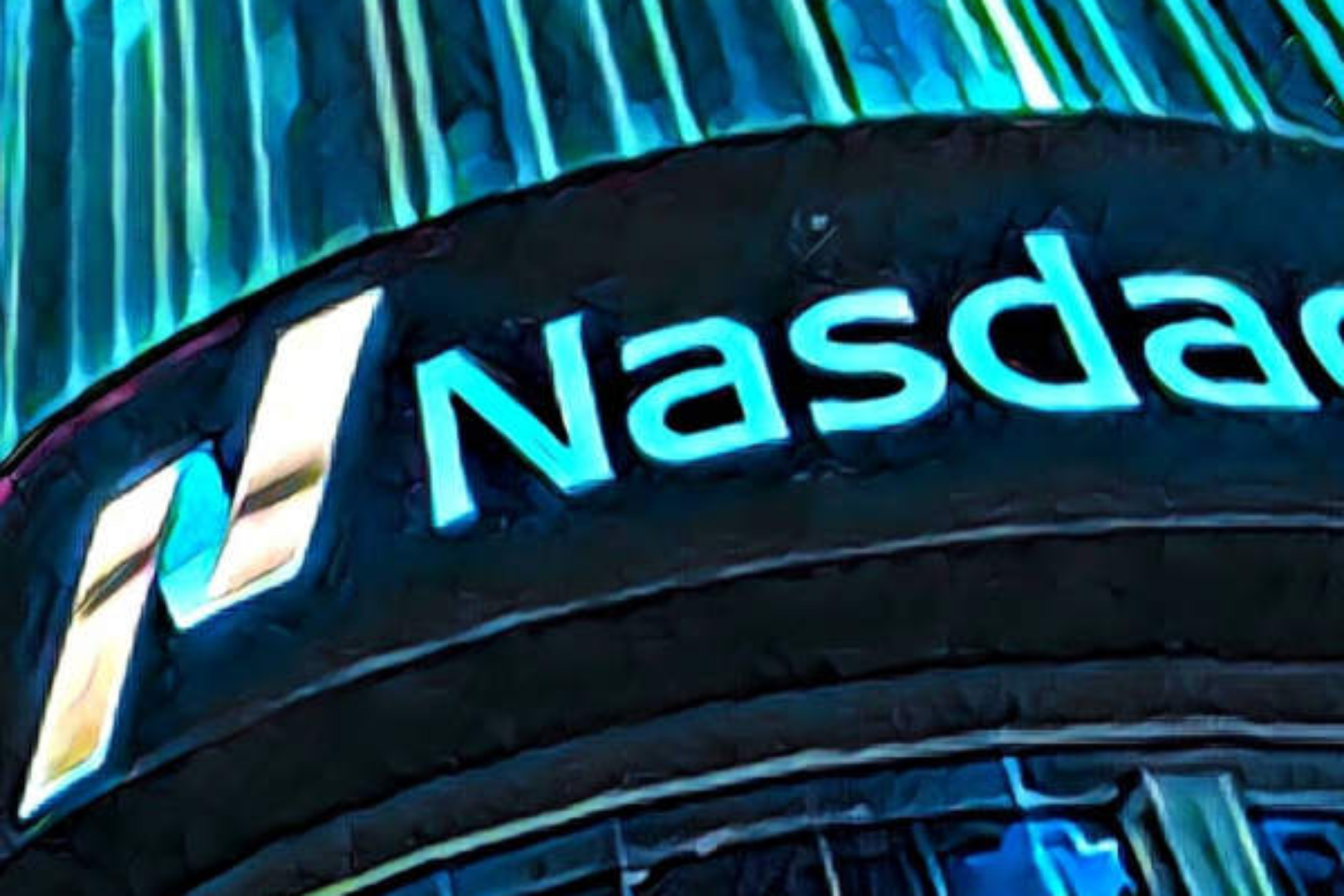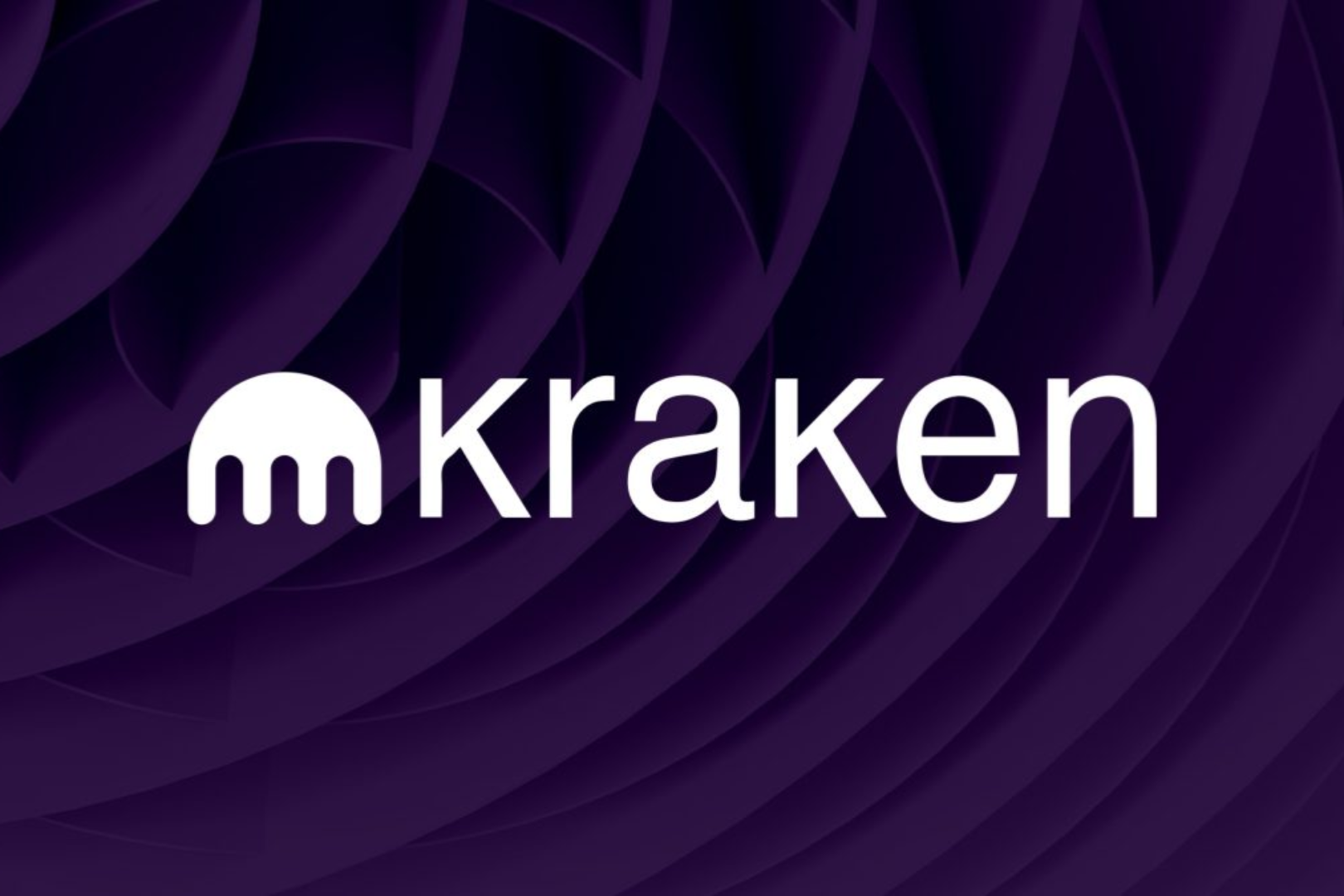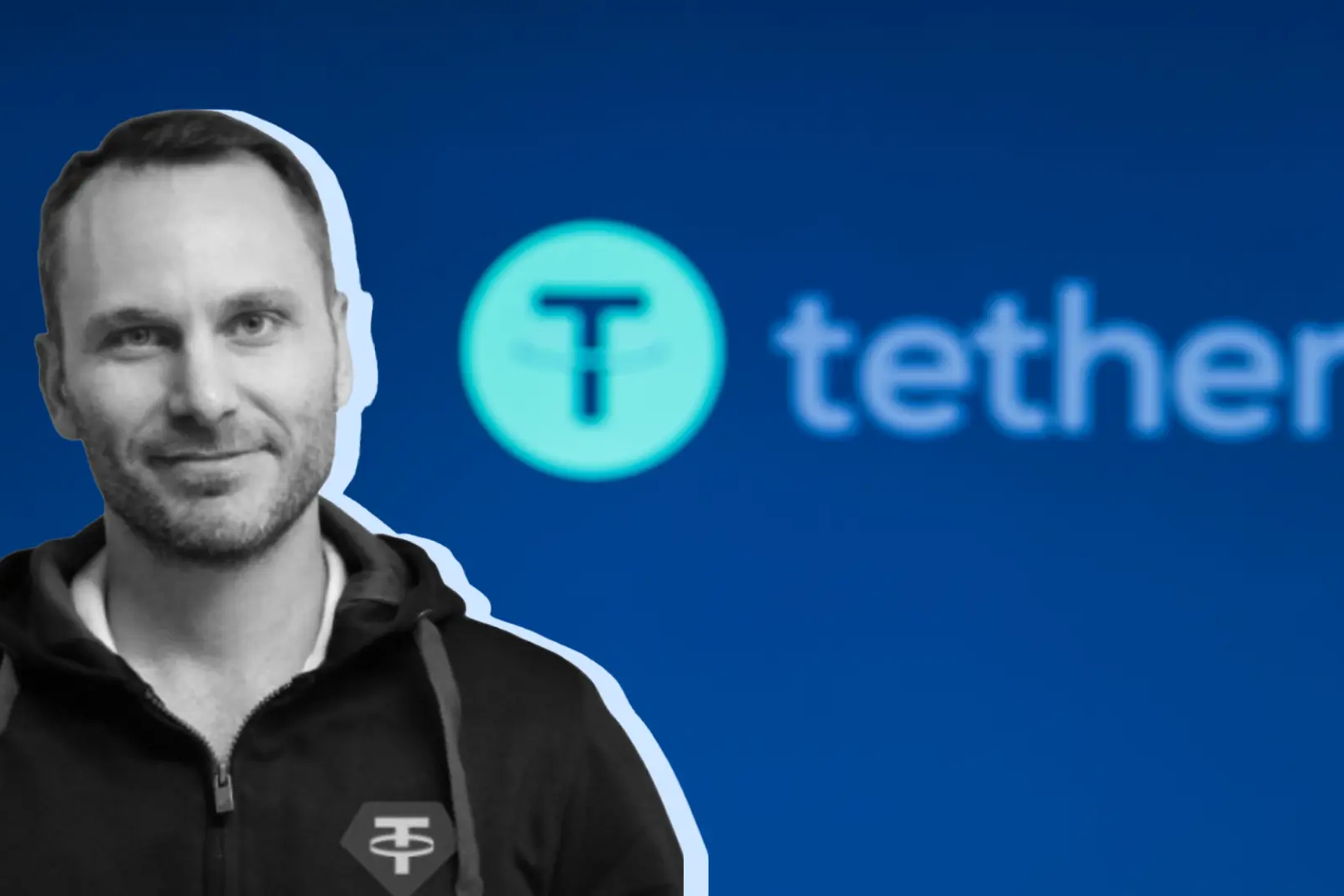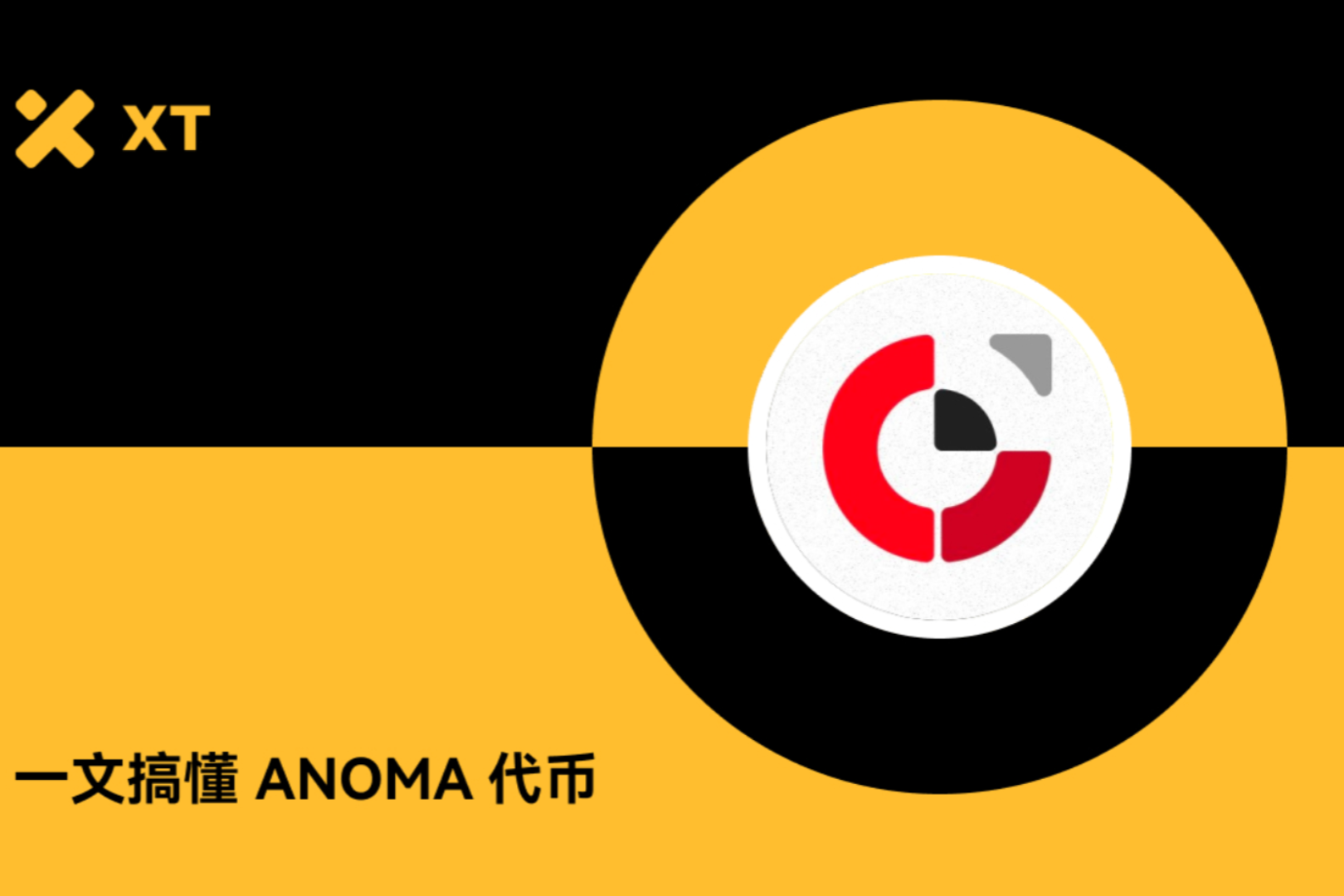
On the evening of January 25th, Odaily teamed up with Web3 giant Pocket Network, top international capital RockTree Capital and Decentral Park Capital to jointly hold an online live broadcast event of "Web3 Pioneer, with you". In this event, let you understand how Pocket Network became one of the most successful blockchains, and investors' views on Pocket(Click to watch the live playback)。
Three guests were invited to this event, namely: Omer Ozden, Chairman of RockTree Capital, Founding Partner and Chief Information Officer of Decentral Park Capital, John Quinn, Founder of Storj Labs, Michael, Co-founder and CEO of Pocket Network O'Rourke.
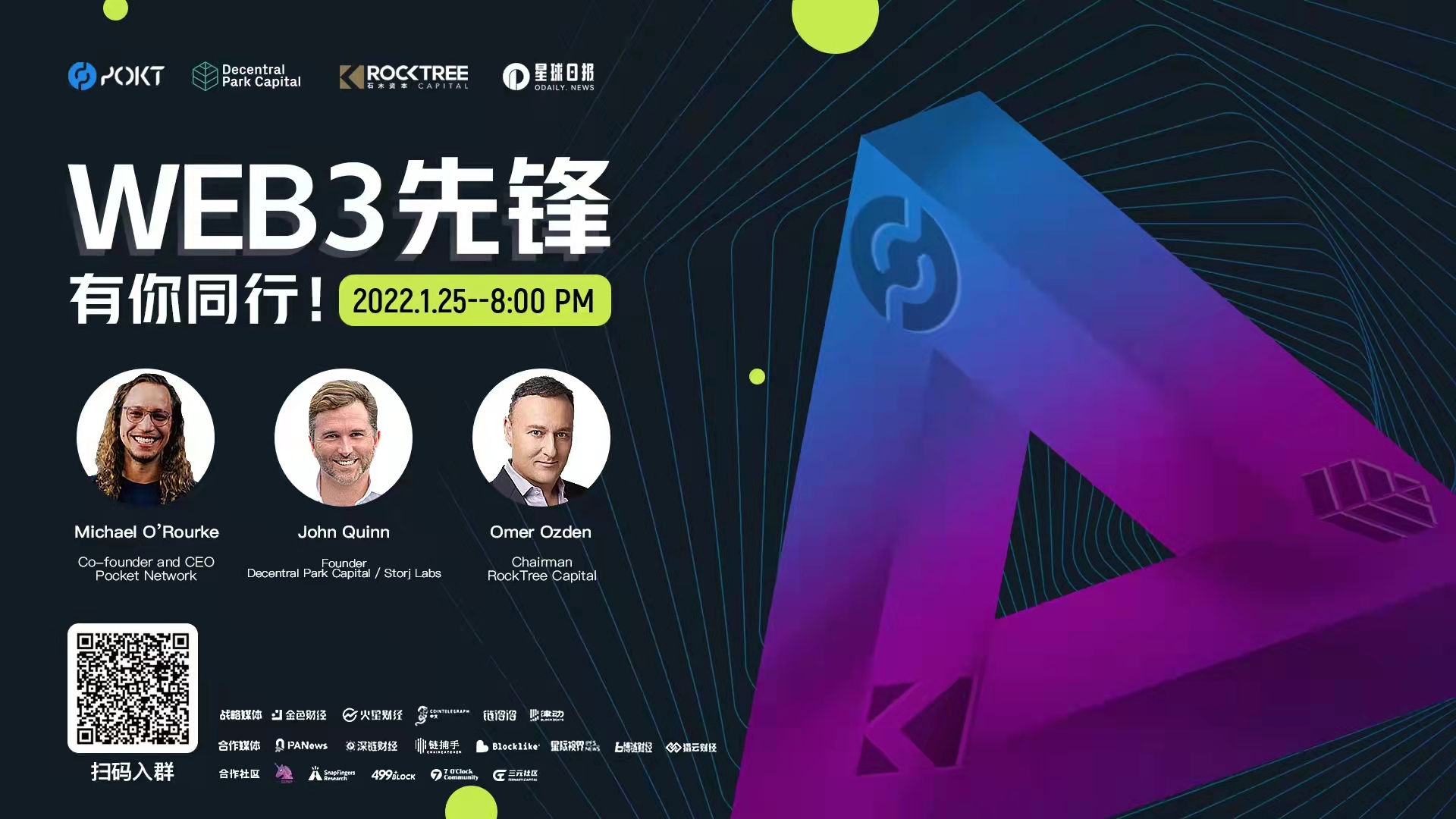
Omer Ozden shares his venture capital perspective. He said that when investing, the company focused on whether the project has a specific application scenario at present, and it must be actually used; in addition, the usage scenario must be able to expand rapidly, and the business model is sustainable, replicable, and scalable It can bring real performance and a certain amount of cash flow to the project; the team itself is full of enthusiasm and has long-term ideas and goals.
Omer Ozden added that Pocket Network met the above requirements and thus received investment from RockTree Capital. Specifically, Pocket Network is an essential and important component in the current Web3 era, with strong usage scenarios, and their income is also growing; more importantly, the Pocket Network team has an open concept and super high execution , able to put ideas into practice.
John Quinn said that the company will first focus on investing in some decentralized technologies that will gradually replace centralized platforms. For example, Pocket Network is a technology company that can use infrastructure to support and realize DeFi scenarios. Furthermore, pay attention to some existing applications and services in the current market. Secondly, we value a team's ability to execute. They need to be able to seize opportunities and implement them. Finally, pay attention to all infrastructure and middleware that can realize DeFi, and Pocket Network is a typical representative.
Michael O'Rourke introduced the development achievements in the past few years:
1. The number of pledge nodes has increased from 700 a year ago to 23,600 now, covering 25 countries around the world;
2. The number of supported public chains has increased from 2 a year ago to 37 now, and is expected to reach 100 by the end of this year;
3. The number of dApps increased by more than 2045;
4. In the past month, the total number of relay services reached 8.57 billion, and now the average is 300 million times per day, and it is expected to achieve 1 billion relay services per day in the future;
5. In the past 30 days, the income on the chain exceeded 150 million US dollars;
6. From the perspective of specific blockchain protocol income, Pocket Network is currently ranked second, and is confident to surpass Ethereum to become the first in the future;
7. With the growth of node and relay services, the number of POKT minted in 2021 will exceed 138 million.
The following is the shorthand of this live broadcast, enjoy~
Moderator Mandy:Welcome to the Odaily live video room, I am the founder and CEO Mandy. Today we invited Omer Ozden, chairman of Rockwood Capital, John Quinn, founding partner and CIO of Decentral Park Capital, and Michael O′Rourke, CEO of Pocket Network. First of all, please say hello to everyone first.
Omer Ozden:Hello everyone, I am the chairman of Stonewood Capital. Rockwood Capital is an early stage investment fund and a boutique merchant bank. It mainly invests in incubation of e-commerce, blockchain and other related projects. We have very rich experience. We are also one of the early investors of Pocket Network.
John Quinn:Hello everyone, my name is John Quinn, and I am the founder of Decentral Park Capital. We are an early digital asset management company. I was also the founder of Storj Labs, a decentralized cloud storage provider.
Michael O’Rourke:Hi everyone, I'm one of the co-founders of Pocket Network. I started to get in touch with Bitcoin in 2013, and then I taught myself IOS and Solidity. It took about five years from the time we had an idea to the actual implementation of Pocket Network.
Q1
Moderator Mandy: As far as I know, not long ago, Stonewood Capital, Decentral Park Capital and two other companies led a new round of 10 million financing for Pocket Network. I'm wondering, how did Omer and John discover Pocket Network in the first place and why did you guys invest in them?
Omer Ozden:Rockwood Capital invests in both traditional and encrypted fields. In the traditional field, we have led investment in projects such as Ucommune, Perfect Diary, and Work Together; in the field of cryptocurrency, we have also invested in The Graph before, which is also a middleware. We are very concerned about the data of their performance and whether this team can drive the development of the market.
From the perspective of investment, we will first pay attention to whether this project has specific application scenarios. Instead of listening to a project promise us that there will be real application scenarios in a few years, we hope that this project will be actually used now, and we also hope that its usage scenarios can be rapidly expanded and appreciated. As an investor with a Wall Street background, the indicators we focus on are whether the project has real performance and stable cash flow, and whether it can bring value to users.
Before investing in Pocket Network, we also communicated with Michael for a long time and had a deep understanding of their team. One thing we value very much about the founder Michael is that he has a high EQ (emotional intelligence), which means that he is A positive leader. For the team, first of all, they must have open and new ideas, and they must also have good execution capabilities to put their ideas into practice. At the same time, there should be a high degree of trust between the teams.
In addition, through our continuous observation and understanding, the performance of the Pocket Network chain is very good, their usage scenarios are also actively expanding, and their income is also increasing.
John Quinn:I will introduce why we invest in Pocket Network from two perspectives.
I have been in contact with this team two years ago, and I also learned about their philosophy, which is to subvert traditional centralized cloud service providers, and their solutions are decentralized. This is also the obsession in Michael's heart, and he is firmly moving toward decentralization. At the same time, they are constantly connecting with various public chains to generate various blockchain applications. Pocket Network is developing very fast in the US and European markets. It is currently entering the Asian market and needs to be accepted by the Chinese market. Therefore, we chose to invest together with Rockwood Capital, which is deeply involved in the Asian market.
From our point of view, Pocket itself is a truly scalable infrastructure, and at the same time it has completed more than 10 billion relay services; it can also connect to many current public chains and provide middleware services. So whether it is Layer1 or Layer2, its performance is very good, so from a vertical point of view, it is a very good infrastructure, and now it can directly connect to multiple chains.
The second general direction is also what Omer Ozden said just now. We are very concerned about the construction of the entire team. Michael himself is also a person who truly unites the team, so we will invest in Pocket.
Omer Ozden:I would like to add that John Quinn is actually our Bole, who discovered the great horse Pocket. At that time Pocket Network had been in operation for five years and their token had been in use for almost 20 months. It was John Quinn who took the Pocket out of the market.
Q2
Moderator: Just now I also heard that the two guests kept mentioning one word in the answer, infrastructure. I believe that the two have always gone from the perspective of long-term market appreciation. I heard that you, Omer, have a title of "Decacorn Hunter". What does this mean? You come from the capital market on Wall Street. What kind of influence does this background have on your investment philosophy in the blockchain industry?
Omer Ozden:The so-called "unicorns" in traditional investment generally refer to companies with a market capitalization of around US$1 billion; now we are talking about "decacorns" that are 10×10, that is, companies with a market capitalization of US$10 billion.
Regarding investment philosophy, first, we do not invest in unicorns, because unicorns are relatively conservative and boring to us in terms of overall philosophy and value, and we are eager to focus on some larger-scale projects. In terms of time, this scale is not one or two years, but can last for a longer period of time and be passed down from generation to generation. We hope to invest in and explore such projects with great potential.
Second, the team itself is full of enthusiasm and has long-term ideas and goals; third, their business model is also sustainable, replicable, and scalable. For example, dYdX, which we invested in, is also a company with a sustainable business model. The same is true for our choice of Pocket Network this time.
Q3
Moderator Mandy: Just now Omer talked about intergenerational opportunities, passing on from generation to generation. I would like to throw this question to John. As a fund focusing on DeFi opportunities, what is your investment philosophy and standards? How does it relate to Web3?
John Quinn:In fact, we have several sets of mature investment standards. First, we focus on investing in some decentralized technologies, which will gradually replace centralized platforms. For example, now we invest in Michael's Pocket Network, which is such a technology company that can use its own infrastructure to support and realize DeFi scenarios.
Second, we are very concerned about some existing applications and services in the market. For example, DeFi, its market value may reach trillions of dollars in the future, and this goal cannot be achieved without some good companies and projects. Third, we attach great importance to the execution ability of a team. When opportunities arise in the market, there needs to be a team that can seize the opportunities and implement them. Fourth, we pay attention to all infrastructure and middleware that can realize DeFi.
To sum up, first, we need to look at the opportunity of the market itself, and second, we need to see whether the team can execute well.
Moderator Mandy: Thanks to Omer&John for sharing the VC investment view with us. Let Michael talk to us about Pocket Network. Please briefly introduce Pocket Network and talk about the original intention of its establishment.
Michael O′Rourke:Pocket Network is actually an intermediate layer protocol that can support a complete set of infrastructure, specific applications related to Web3, and various data operations and storage on the blockchain.
The germination of creating Pocket Network began in 2016, and by 2017, we found a very bad trend. At the time, the vast majority of nodes were using Infura, the Ethereum network API provider, but it was centralized and there was a risk of a single point of failure. Therefore, we decided to provide a decentralized cloud service solution. This protocol is the Pocket Network we see today, which can achieve the purpose of decentralization and lower the barriers for developers to enter the blockchain.
Q4
Moderator Mandy: Indeed, Infura has many problems. The Pocket Network project was established in 2017, and the main network was officially launched in 2020. During these three years, what problems did the team encounter in the process of building products and how did they solve them?
Michael O′Rourke:We have always had a philosophy from the beginning of our establishment to find the problems we urgently need to solve, and I recently found a list of problems that we made a few years ago.
At that time, our idea was to build our own protocol with the help of Ethereum. At the beginning, we made several Pocket smart contracts on Ethereum; as time went by and our team changed, we expanded the smart contracts to other blockchains.
I believe that many viewers and listeners here understand that the Gas fee was very high during the operation of Ethereum. By 2017, such problems still exist, so from 2017 to the next three to five years or so, Pocket Network has been trying to put solving problems in the first place. What are some good ways to understand these issues? What is the most efficient and best way to solve these problems? Until we have an architecture that solves the problem. This is how Pocket Network goes online step by step.
Q5
Moderator Mandy: It has been more than a year since the Pocket Netwrok mainnet was launched. It is currently known as the Web3 solution of Amazon Cloud Services. The data on the chain is very beautiful and amazing. So how is Pocket currently operating? What data can be shared with you?
Michael O′Rourke:
(1) The number of pledged nodes. A year ago, the total number of Pocket Network staking nodes was only 700, and this year it reached 23,600. This means that we now cover more nodes and more countries, almost 24 or 25 countries, and can provide infrastructure for Web3 applications in these countries.
(2) The number of public chains supported. A year ago, the number of public chains we supported was only 2, but now we support 37 public chains, and it is expected that by the end of this year, the number of public chains we will support can reach as high as 100.
(3) The number of dApps now exceeds 2045. In particular, we released Pocket Dashboard, which can bring a better and more convenient experience for developers.
(4) The number of relay services reached 8.57 billion times in the past month. Half a year ago, we were able to complete no more than 1.5 million times per day, as little as 1 million or 700,000 times; now, we can basically achieve 300 million times of relay services per day. It is estimated that in the near future, we can achieve about 1 billion relay services per day, and 30 billion times per month.
(5) The growth of Pocket Network relay services in 2021 is due to the increase in the number of our pledged nodes, and the performance of our incentive layer is very good, the income is also high, and the use of POKT, so the relay service from January to December The numbers are constantly growing. Judging from the proportion distribution between the mainnets from 2020 to 2021, Harmony is still the blockchain with the most relays in the Pocket Network, followed by the Ethereum network, followed by Polygon and Fuse. Over time, the proportion of different public chains will reach a balance in the future.
(6) From a quarterly perspective, the number of staking nodes in 2021Q1 is relatively low, only 3,438, and reached 18,176 in Q4; and in the next few quarters, the number of minting and relay services of Pocket Network POKT has grown exponentially. In 2021, we will mint a total of over 138 million Pockets.
In terms of the revenue performance of specific blockchain protocols, we are now ranked second, second only to Ethereum. Of course, we are also confident that we will gradually surpass Ethereum in the near future.
(7) Over the past 30 days, we've had over $150 million in revenue. In the future, we can perform better.
Finally, I am very happy to invite two leading investors to join me in the meeting today. It is precisely because of their leading investment of US$10 million in the previous round that we have truly seized this opportunity.
Q6
Moderator Mandy: We know that in a blockchain network, the more nodes there are, the higher the degree of decentralization is, and the stronger the network stability will be. How is Pocket Network doing to further improve decentralization? How do you incentivize more nodes to join? Tell us about the Pocket incentive layer and the emergence of Node-Fi; also, what do you call the POKT economic flywheel?
Michael O′Rourke:Explain the POKT economic flywheel. Our token POKT has two specific applications: First, by staking POKT, we can actually use our related services and applications. Second, node operation is carried out by purchasing POKT.
Specifically, developers can obtain free available relays during the pledge period by staking POKT, and the amount of POKT that needs to be pledged is proportional to the number of available relays. Currently, for every POKT pledged, 13.3684211 relays can be used in one session (one session is 60 minutes long), but the governance mechanism will adjust this parameter in due course according to the price fluctuation of POKT token.
Node providers can obtain POKT by deploying hardware and providing resources. Each successful relay service will mint 0.01 POKT as a reward, of which 89% will be allocated to the service node that completes the relay work, and 1% will go to the block producer (that is, generate block verification nodes), and the remaining 10% goes to the Pocket DAO Foundation. However, the node provider also needs to pledge POKT in each node, mainly to ensure the stability of the node in providing data services. Once the operating node sends invalid data or continues to go down, it will be punished accordingly. The minimum stake required to run a single node is 15,000 POKT; additional tens to hundreds of POKT are typically staked to prevent slashing penalties.
To sum up: Nodes can obtain incentives by maintaining the operation of the Pocket Network network, and at the same time assume obligations; developers pledge tokens as a fee for using the network. It should be emphasized that developers are actually using the network for free to some extent, and the cost is almost zero.
Now we have found a good trend, some people are not only running nodes at home, but running our nodes in more scenarios.
Q7
Moderator Mandy: I would like to ask Omer and John, from an investment point of view, how will your investment change the game now? What kind of emerging blockchain projects would you consider?
John Quinn:In the short term, I think the important application of Web3 will develop rapidly.
The first is in the financial field. The blockchain has been called a natural ledger from the very beginning, so such DeFi financial projects may develop rapidly.
The second is specific applications for consumers. Being consumer-oriented means that the technical content and technicality itself does not necessarily need to be so high. Just like the popular NFT now, ordinary people can understand it. In addition, games are also applications that blockchain can quickly implement in the future, including game platforms. With the blockchain, games may also flourish in another dimension in the future.
Speaking of Pocket, it is also a wide-ranging infrastructure-based Web3 application, and it will also make a difference in this wave.
Omer Ozden:From my point of view, the direction of future investment may be DeFi and "Finance 2.0".
Before 2020, although we are optimistic about DeFi and cryptocurrencies, they have not been accepted and used on a large scale in terms of technology or environment, and the transaction volume has not increased on a large scale; Explosive growth. Therefore, the direction of future investment must be in the DeFi field.
Previously we invested in a decentralized derivatives project called dYdX. In 2020, its daily transaction volume is only 10 million US dollars. By 2021, the daily transaction volume will increase to 10 billion, which can be said to be a growth rate of more than a thousand times. This is the technological innovation based on Web3.0.
Previously, Michael shared that Ethereum is still the public chain with the highest income, not because its technology is the most advanced, but largely because it is a pioneer with a first-mover advantage. This means that it can become a standard setter and an industry leader.
We are also very happy to see that Pocket is also such a revolutionary leader with a first-mover advantage, and its commercial performance is also very beautiful. Just now Michael also said that even though it was only docked with 2 public chains at the beginning, but now there are 37 public chains, it can be said that it has truly become a multi-chain king; the number of pledge nodes has also increased from a few hundred to 2 More than ten thousand. These changes in data mean that Pocket Network is a pioneer that has successfully seized the intergenerational advantages and opportunities of the times, which is what we value.
Q8
Moderator: Two investors, with the emergence of Pocket Network and other projects, what do you think will happen to the prospects of Web3?
Omer Ozden:In my opinion, the prospect is very clear, the development of blockchain will be very fast, and Web3 will be accepted by the public just like the Internet Web1 we encountered at the beginning.
In the era of Web1, the number of our email and mailbox users went from 50 million at the beginning to 500 million at the end, and it only took a few years; the same speed of development, I believe, will happen in Web3 and the entire cryptocurrency field , users will continue to increase. They may not realize that they have become Web3 users, but they have already started to contact related services, such as DeFi, GameFi and some native financial products.
Now our encrypted financial products look very complicated, and it will become very simple after a while. The core technology behind this simplification is the related application of Web3.
In our opinion, Web3 is not an alternative among various alternative directions, it is more a better choice and a natural development of an era.
John Quinn:My personal background is that I myself have lived through the Internet 1.0 era and the technological chaos of the time. Many large centralized groups such as Google and Amazon have naturally become technology monopolies in the Internet age. What we have to do now is to break these technological monopolies and achieve transparency and decentralization. Decentralized applications in technical scenarios are more about "disintermediation". The "middleware" is replaced by Web3 middleware, just like Pocket.
I want to introduce a new concept to you, product-market fit. In the long-term market development, what kind of products are more suitable for the development of this era, and what is the most conducive state for development. In this era, banks are no longer trusted, and large companies are often criticized for their lack of transparency. Therefore, in such an era, decentralized products are the most suitable and suitable for this era. We have a saying "code is law" and that's what it means.
In the long run, finance will naturally embrace decentralization, but the process is difficult. Just like the music industry and publishing industry back then, they also went through a painful process from tradition to electronics. Financial industries like DeFi are relatively far away from consumers and have relatively high requirements.
As mentioned earlier, it is consumer industries that can develop rapidly, such as games and NFT, because these industries do not require such a high technical threshold and are relatively simple to understand. When absorbing initial users, it also has natural advantages, allowing more ordinary people to try to experience what is called the value of the chain, and it can also allow more people to quickly understand what is the application of the Web3 era.
We have repeatedly talked about the specific application of DeFi. I believe this is also the advantage of Pocket Network. They are not only concerned with a certain vertical industry, but cover the horizontal state of different vertical industries. To give a simple example, when we race horses, traditional buyers will only bet on one horse; in such a scenario, Pocket Network has selected all the horses, covering all vertical fields, which is their future The development also represents their future trend.
Q9
Moderator Mandy: I would like to ask Michael, what new plans does PocketNetwork have this year? What is the next milestone of Pocket Network worth looking forward to? How are you going to achieve your goals?
Michael O′Rourke:First of all, we need to further expand the number of public chains. By the end of this year, the number of public chains will reach 200; moreover, it is expected that in the near future, we will achieve about 1 billion relays per day. I believe this goal can be achieved; Secondly, we just launched a new project wPOKT not long ago, allowing users to pay to use our basic services to bring them a better experience; finally, I would like to explain the blessings of Pocket Network from the depth and breadth. Although the number of our public chains is increasing and the breadth of the market is constantly expanding, we will not give up digging deep into each public chain. The above points are the goals I want to achieve this year.
Q10
Moderator Mandy: We have learned about the views and visions of the three on the Web3 field. The last question I want to ask the three of you is what attracts you to each other? In this field, partners are very important, and it is more important that partners have the same thinking and ideas.
John Quinn:Whether in the blockchain space, or in any emerging industry, the partnership itself is crucial. We talk about Layer1 and Layer2 today, but I want to define Layer0 as the person himself. Whether the market is strong or the market is weak, it is very important to always be able to be by your side and support your partners.
This month we just completed a $75 million fund project, which received huge support from Stonewood Capital, mainly targeting the Asian market. We always have a belief that to make a global project, we cannot separate from the Chinese market, nor the entire Asia-Pacific market. In order to better understand the Asia-Pacific market and the Chinese market, we rely heavily on the support and assistance of Stonewood Capital, including our cooperation with Michael.
Working with a founder/company/project is like we're on a journey together, and we need to support the founder. Because all the future times will not only have sunshine and rainbows, but also many hardships and wind and rain. We should not only provide them with funds, but also provide them with relevant advice, encourage them to go one step further, and truly empower these founders to realize their ideas. I think these are the real cooperation and win-win.
Omer Ozden:I value people very much. In fact, I really came to the Chinese market and learned about Beijing through the three founders of New Oriental (Yu Minhong, Xu Xiaoping and Wang Qiang), and I also cooperated a lot with ZhenFund. Through many years of cooperation and running-in with them, I also realized that the essence of investment is not to choose a certain excellent business model, nor to look at the best market, but to focus on people themselves. Our investment strategy is to choose the best partners, which is why we always maintain a close relationship with the founders.
DeFi itself is a real investment that requires multiple industries, multiple experts, and a high degree of concentration. In the DeFi team, there are a lot of young people who are watching and aiming at opportunities day and night, with their eyes fixed on them. We need such people. With Pocket, we are not talking about specific projects, but a good handshake. Through this handshake, I can understand whether this partner is trustworthy or not.
Whether it is blockchain or DeFi, it is a very small circle, and the trust between people is even better than our initial understanding of their technology itself. As I just said, the Pocket team is a team with high emotional intelligence and high execution ability, so it is our very trusted partner.
I always believe that to make a protocol run efficiently, it is inseparable from good technical support, solid user cases and efficient user management. These professional-level things are what the Pocket team is good at. What we are more good at is capital management, external communication, media publicity, PR, preparation for listing and operation, and docking with law enforcement officers in related industries. Maybe neither of us can be perfect, but the cooperation of both parties can truly create a 360° circle.
Michael O′Rourke:In fact, we met John because a friend connected us. When I met John, I told him about deep technical issues, and we had an in-depth conversation with each other on the concept of decentralization, and we were able to see the entire market scene. We feel that the whole process can be implemented, and we have this expectation. I think this feeling is very good.
In the process of talking about technology with John, I became very confident, and felt that the whole person became very self-contained and relaxed. I also think this is one of the best decisions I have made in my life.
The acquaintance with Omer, I thought he would tell this story, but he didn't, so I will tell it. We also have an investor friend who we know together, and he introduced us to each other. I remember being in Mexico, we met one night and we started talking.
In fact, I have always had an idea. When I can get investors' investment and work for them, I think I must cherish this opportunity and push this partnership to an investable, trustworthy, and transparent value. direction.
Omer Ozden:Michael and I actually met in Mexico. We drank Mexican baijiu that day, which is the way Chinese people do business: eat and drink. But I didn't know that at that time, I was toasting to the "future Bezos".
【Q&A session】
Moderator Mandy: First of all, I would like to ask Michael, as the founder and CEO of Pocket Network, what do you think are the differentiating advantages of Pocket compared with other competing products? And I learned that Pocket will increase with the number of node verifications, will it cause inflation?
Michael O′Rourke:Let me talk about our advantages first. As of now, I have not seen a service provider in the market that is similar to our decentralized network. Most of our competitors are still some traditional centralized players, so our market is very advantageous.
And I also found a very interesting phenomenon. The infrastructure we are doing now can be said to be a very valuable commodity. The infrastructure provided by Pocket Network is inherently lower in cost and more sustainable. It can also surpass traditional centralized infrastructure in all aspects. Just now John also said that the future trend is to "replace middlemen with middleware", which will greatly reduce the cost of the entire commercial society, which is our first advantage.
The second advantage is high reliability. Just shared our latest data with you, the service scope covers about 25 countries, and the total number of pledge nodes exceeds 23,000. Compared with AWS, they often go down. I believe that in the case of a deep market, such a risk is actually unacceptable to many people, but we have never had such a situation.
The second problem is inflation. As the overall traffic increases, both the DAO and the entire community will consider lowering our rewards accordingly. Because it is necessary to achieve the balance of the entire community and network. So we will adopt the method of controlling the number of nodes at that time, or use the method of reducing reward returns to achieve balance and prevent inflation. In fact, we have written this article in the agreement itself, but because we are still in the early stage and rapid growth stage, we have not yet started to apply it.
Moderator Mandy: The second question, ask John, you once founded Decentral Park Capital, the world's top asset management company, and Storj Labs, a decentralized cloud storage company. In your opinion, how big is the market size and development prospects of decentralized cloud storage, and can it subvert traditional cloud service providers such as Amazon Cloud?
John Quinn:Now common cloud storage platforms, including Amazon's AWS, Google Cloud, and Microsoft's Azure, provide more packaged services. Their market size and application range can be said to be huge, and expansion and upgrade are also very convenient. . In essence, it tests a kind of storage capacity, and their market is growing very fast. As you all know, the amount of data can be said to be increasing every day, which is traditional cloud storage and centralized platforms.
Decentralized cloud platform, its development direction is actually very good, no matter in terms of efficiency, cost, scale expansion and the services it provides, it has very good advantages. Like what we call Pocket today, it provides related services.
First of all, it can integrate multiple public chains; at the same time, it is also multi-application, and the cost is controllable compared with traditional methods. Now Pocket is doing a pioneering experiment, and we have not seen any traditional enterprise or project in the market. Pocket is currently benchmarking and trying to surpass Infura. In essence, it is still based on the traditional center, and it is partly dependent on the AWS system. So, Pocket will gradually replace Infura, and we see its market share increasing.
Moderator: Last question, why does Pocket wallet have different modes on Ethereum? In the future, which communities or projects will Pocket focus on in the Chinese market? Are there any planned activities?
Michael O′Rourke:First of all, Pocket has its own blockchain, and we have also established our own wallet, including the entire infrastructure, we all start from scratch. So at the beginning of the design, there was indeed a computer-side wallet, and later there were mobile-side and mobile-side wallets. It does have different designs according to different scenarios. This is not like our traditional use of tokens on Ethereum for good integration, because we are building infrastructure and blockchain from scratch, so there will be different models.
We are very happy to come to China to carry out some community activities, and we also want to make a small advertisement here. If any community or media wants to connect or coordinate with us, we are very happy to cooperate. After the epidemic is over, we think that the first stop for offline activities may be China and the entire Asia-Pacific market. So if there is a team willing to cooperate with us, please contact us.

